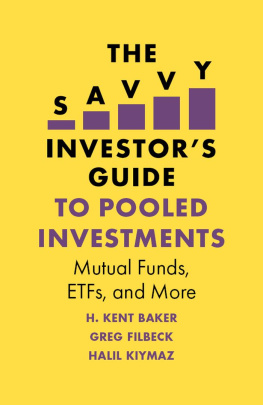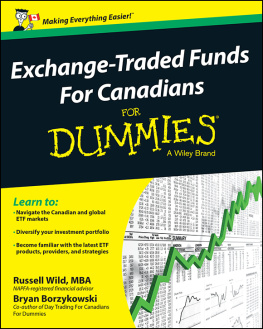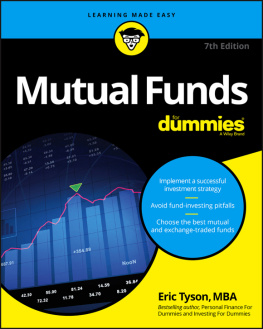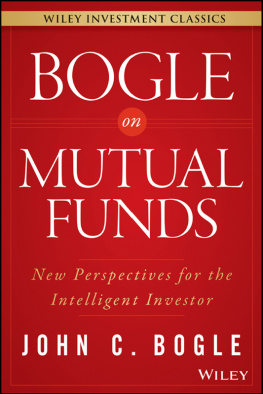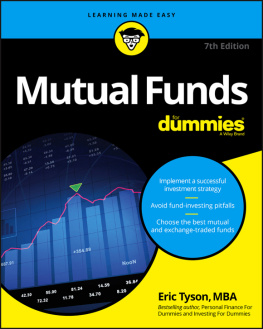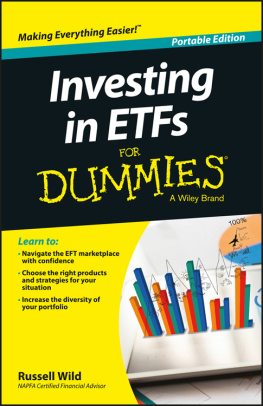THE H. KENT BAKER INVESTMENTS SERIES
THE SAVVY INVESTORS
GUIDE TO POOLED
INVESTMENTS
Mutual Funds, ETFs,
and More
THE H. KENT BAKER INVESTMENTS SERIES
THE SAVVY INVESTORS
GUIDE TO POOLED
INVESTMENTS
Mutual Funds, ETFs,
and More
BY
H. Kent Baker,
Greg Filbeck
and
Halil Kiymaz

Emerald Publishing Limited
Howard House, Wagon Lane, Bingley BD16 1WA, UK
First edition 2019
Copyright 2019 Emerald Publishing Limited
Reprints and permissions service
Contact:
No part of this book may be reproduced, stored in a retrieval system, transmitted in any form or by any means electronic, mechanical, photocopying, recording or otherwise without either the prior written permission of the publisher or a licence permitting restricted copying issued in the UK by The Copyright Licensing Agency and in the USA by The Copyright Clearance Center. Any opinions expressed in the chapters are those of the authors. Whilst Emerald makes every effort to ensure the quality and accuracy of its content, Emerald makes no representation implied or otherwise, as to the chapters suitability and application and disclaims any warranties, express or implied, to their use.
British Library Cataloguing in Publication Data
A catalogue record for this book is available from the British Library
ISBN: 978-1-78973-216-0 (Print)
ISBN: 978-1-78973-213-9 (Online)
ISBN: 978-1-78973-215-3 (Epub)

CONTENTS
LIST OF FIGURES
Chapter 1 |
Chapter 3 |
Chapter 5 |
ABOUT THE AUTHORS
H. Kent Baker, DBA, PhD, CFA, CMA, is a University Professor of Finance in the Kogod School of Business at American University. He is an award-winning author/editor of more than 30 books, including Investor Behavior The Psychology of Financial Planning and Investing and Investment Traps Exposed Navigating Investor Mistakes and Behavioral Biases. With nearly 300 other publications, Professor Baker is among the top 1% of the most prolific authors in finance.
Greg Filbeck, DBA, CFA, FRM, CAIA, CIPM, PRM, is the Samuel P. Black III Professor of Finance and Risk Management and Director of the Black School of Business at Penn State Behrend, The Behrend College. He has authored or edited 10 books and published more than 100 academic articles. Professor Filbeck has conducted training for professional designations for the last two decades.
Halil Kiymaz, PhD, CFA, is the Bank of America Professor of Finance in the Crummer Graduate School of Business at Rollins College. He maintains an extensive research agenda and has published more than 85 articles in scholarly and practitioner journals and four books. Professor Kiymaz has received several research awards and is the Finance Area Editor of the International Journal of Emerging Markets.
ACKNOWLEDGMENTS
If theres a book that you want to read, but it hasnt been written yet, then you must write it.
Toni Morrison
We took Toni Morrisons advice to heart and wrote The Savvy Investors Guide to Pooled InvestmentsMutual Funds, ETFs, and More. Many people played an important role in this process. We thank our partners at Emerald Publishing for their many contributions, especially Charlotte Maiorana (Senior Editor) and Nick Wolterman (Assistant Editor). We also appreciate the research support provided by our respective institutions the Kogod School of Business at American University, Black School of Business at Penn State Behrend, and Crummer Graduate School of Business at Rollins College. Finally, we dedicate this book to our families: Linda and Rory Baker; Janis, Aaron, Andrea, Kyle, and Grant Filbeck; and Nilgun and Tunc Kiymaz.
INTRODUCTION
Investing can be a murky business, like driving on a foggy day on an unfamiliar road. Its easy to get confused and you may want to turn around and return home. However, dont stop driving just because weather conditions are not always ideal. Learning how to become a savvy investor is not as hard as it may seem. Once you get through the murky parts, your trip wont be as daunting and youll also enjoy a smoother and safer ride to reaching your financial goals. As Warren Buffet notes, Investing is simple, but not easy.
Are you someone who has a relatively small amount of money to invest? If so, you may think that you have only a few investment choices, but youd be wrong. One of the most common ways to invest is through a pooled investment vehicle (PIV). A PIV is an investment fund that commingles the monies of many different investors to buy a portfolio that reflects a particular investment objective. Thus, PIVs are formed by aggregating relatively small investments from many individuals who want to participate in investments that would otherwise be available only to large investors. A wide range of PIVs are available that invest in different assets with distinctive investment strategies. Investing in PIVs can be more accessible and less risky than directly buying shares in individual companies or real assets such as real estate.
PIVs offer many inherent benefits of being part of a group of investors. Perhaps, the most important advantages are professional management and diversification. Additionally, most PIVs are subject to government oversight and many offer high liquidity, which describes the degree to which you can quickly buy or sell an asset or security market without affecting its price.
Of course, investing in PIVs isnt without some disadvantages. Two major drawbacks involve costs and a lack of choice and control. In investments, theres an old saying that Theres no such thing as a free lunch, meaning that you dont get something for nothing. You cant invest in PIVs for free. Hence, PIVs charge fees and expenses that eat up part of your returns. Although you can select the PIV in which to invest, you dont have any control over the types of individual holdings that make up the fund. Thus, you cant customize your portfolio. You also have less control over the recognition of income as well as gains and losses for tax purposes.
You should keep in mind that all PIVs, just like all other types of investment, carry risks. Different PIVs have different levels of risk. Thus, before selecting any PIV, you should be sure it offers the right level of risk for you. That is, the PIV could be consistent with your risk tolerance, which is the degree of variability in investment returns that you are willing to endure. If you dont have a realistic understanding of your ability and willingness to tolerate large swings in the value of your investments, you are likely to take on too much risk and possibly panic and sell at the wrong time.
Given that you are ultimately responsible for your investment decisions, you need to avoid the common pitfall of investing in something that you dont understand. This is where The Savvy Investors Guide to Pooled Investments comes into play. Although many different PIVs are available, this book focuses on PIVs that are readily available to the general public. For example, you dont need much money to gain entry into open-end funds (OEFs) also called mutual funds, exchange-traded funds (ETFs), closed-end funds (CEFs), unit investment trusts UITs), and real estate investment trusts (REITs). OEFs, CEFs, and UITs have been around for many decades compared to ETFs and REITs, which are relatively recent innovations in the fund business. Although OEFs are by far the largest, this fact doesnt mean that they are always your best choice or that you should ignore other PIVs.

